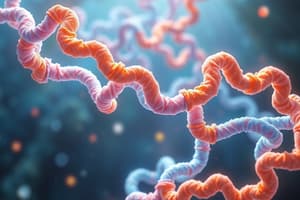Podcast
Questions and Answers
What type of bond is responsible for bonding chains of amino acids in proteins?
What type of bond is responsible for bonding chains of amino acids in proteins?
- Ionic bond
- Hydrogen bond
- Covalent bond
- Peptide bond (correct)
Which of the following is a correct sequence in protein synthesis?
Which of the following is a correct sequence in protein synthesis?
- DNA -> mRNA -> Protein (correct)
- RNA -> DNA -> Protein
- RNA -> mRNA -> Protein
- DNA -> tRNA -> Protein
What type of test can be used to detect the presence of proteins?
What type of test can be used to detect the presence of proteins?
- Biuret's test (correct)
- Benedict's test
- Millon's test
- Lugol's test
What is the main function of vitamin A?
What is the main function of vitamin A?
What is the main role of vitamin K?
What is the main role of vitamin K?
What is the primary function of vitamin E?
What is the primary function of vitamin E?
Which type of vitamins need the liver and gallbladder for absorption?
Which type of vitamins need the liver and gallbladder for absorption?
What is the main purpose of hydrogenation of unsaturated fats?
What is the main purpose of hydrogenation of unsaturated fats?
What is the function of phospholipids in the body?
What is the function of phospholipids in the body?
Where are glycophospholipids primarily found?
Where are glycophospholipids primarily found?
What is the function of sphingophospholipids?
What is the function of sphingophospholipids?
What is the primary role of triglycerides?
What is the primary role of triglycerides?
Why is vitamin D important?
Why is vitamin D important?
What does unsaturation refer to in lipids?
What does unsaturation refer to in lipids?
What happens during fatty acid oxidation?
What happens during fatty acid oxidation?
What are the four levels of protein structure, and what distinguishes each level from the others?
What are the four levels of protein structure, and what distinguishes each level from the others?
Explain the process of protein synthesis, including the roles of DNA, mRNA, and ribosomes.
Explain the process of protein synthesis, including the roles of DNA, mRNA, and ribosomes.
What is the Biuret’s test, and how is it used to detect the presence of proteins?
What is the Biuret’s test, and how is it used to detect the presence of proteins?
What is the process of hydrogenation of unsaturated fats?
What is the process of hydrogenation of unsaturated fats?
What is the main function of sphingophospholipids?
What is the main function of sphingophospholipids?
What is the role of vitamin E in the body?
What is the role of vitamin E in the body?
What is the primary function of vitamin K?
What is the primary function of vitamin K?
What are the characteristics of water-soluble vitamins?
What are the characteristics of water-soluble vitamins?
What is the main role of triglycerides in the body?
What is the main role of triglycerides in the body?
What is the process of Vitamin D metabolism and synthesis involving 7-dehydrocholesterol?
What is the process of Vitamin D metabolism and synthesis involving 7-dehydrocholesterol?
What is the main function of phospholipids in the body?
What is the main function of phospholipids in the body?
What is the main function of Vitamin A in the body?
What is the main function of Vitamin A in the body?
What are the functions of Vitamin B2 in the body?
What are the functions of Vitamin B2 in the body?
What is the process of fatty acid oxidation?
What is the process of fatty acid oxidation?
What are the characteristics of fat-soluble vitamins in terms of absorption?
What are the characteristics of fat-soluble vitamins in terms of absorption?
Flashcards are hidden until you start studying
Study Notes
Protein Structure and Function
- Peptide bonds are responsible for bonding chains of amino acids in proteins.
Protein Synthesis
- The correct sequence in protein synthesis is: DNA → mRNA → ribosomes.
Protein Detection
- The Biuret's test is used to detect the presence of proteins.
Vitamins and their Functions
- Vitamin A: essential for vision, immune function, and gene transcription.
- Vitamin K: plays a crucial role in blood clotting and bone metabolism.
- Vitamin E: acts as an antioxidant, protecting cells from damage.
- Vitamin D: essential for bone health, immune function, and calcium absorption.
Lipid Functions
- Phospholipids: major component of cell membranes, involved in cell signaling and transport.
- Glycophospholipids: primarily found in brain tissue, involved in cell signaling and neural function.
- Sphingophospholipids: involved in cell signaling, nerve function, and apoptosis.
- Triglycerides: primary function is energy storage.
Lipid Chemistry
- Hydrogenation of unsaturated fats: adds hydrogen to unsaturated fatty acids, making them more saturated.
- Fatty acid oxidation: process by which fatty acids are broken down to produce energy.
- Unsaturation: refers to the presence of one or more double bonds in a fatty acid chain.
Vitamin Absorption
- Fat-soluble vitamins (A, D, E, and K) require the liver and gallbladder for absorption.
Triglyceride Function
- Triglycerides are the primary storage form of energy in the body.
Vitamin Metabolism
- Vitamin D metabolism and synthesis involves the conversion of 7-dehydrocholesterol in the skin upon UVB exposure.
Studying That Suits You
Use AI to generate personalized quizzes and flashcards to suit your learning preferences.




